Galant Schemata on:
[Wikipedia]
[Google]
[Amazon]
Galant Schemata, as described by
 The
The 
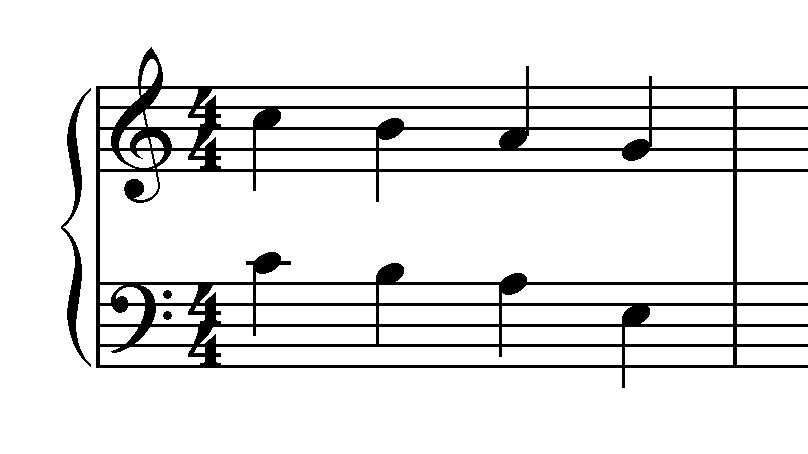
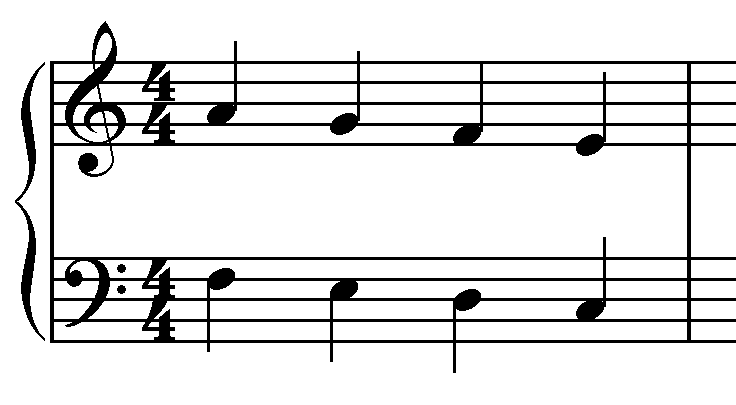 Gjerdingen describes the Prinner as a "riposte" to an opening schema. A Prinner melody features some form of stepwise descent from scale degree 6 to scale degree 3, and the bassline features stepwise descent from scale degree 4 to scale degree 1. A variant of this schema exists with an optional extension in the third event with scale degree 5 in the bass to strengthen the finality of the musical phrase. Composers in the galant period also favored the Prinner as a useful way to modulate from a key to its dominant. Prinners used in this manner are distinguished as modulating Prinners.
Gjerdingen describes the Prinner as a "riposte" to an opening schema. A Prinner melody features some form of stepwise descent from scale degree 6 to scale degree 3, and the bassline features stepwise descent from scale degree 4 to scale degree 1. A variant of this schema exists with an optional extension in the third event with scale degree 5 in the bass to strengthen the finality of the musical phrase. Composers in the galant period also favored the Prinner as a useful way to modulate from a key to its dominant. Prinners used in this manner are distinguished as modulating Prinners.
 The Fonte features four events in two groups of two, or "dyads". The first group is a pair of harmonies in a minor key, and the second group is in a major key. Composers used the Fonte to briefly deviate from the main key of a piece, essentially tonicizing the supertonic of the main key in the first group of events and following it with cadential action in the main key in the second group. The Fonte melody typically features two recognizable sets, corresponding to the two groups of events. The second melodic set in a Fonte is a step lower than the first set. A concept related to the Fonte is the descending fifth
The Fonte features four events in two groups of two, or "dyads". The first group is a pair of harmonies in a minor key, and the second group is in a major key. Composers used the Fonte to briefly deviate from the main key of a piece, essentially tonicizing the supertonic of the main key in the first group of events and following it with cadential action in the main key in the second group. The Fonte melody typically features two recognizable sets, corresponding to the two groups of events. The second melodic set in a Fonte is a step lower than the first set. A concept related to the Fonte is the descending fifth

 The Do-Re-Mi is another common "opening gambit." This schema features three events. Like the name suggests, a Do-Re-Mi melody features stepwise ascent from scale degree 1 to scale degree 3. In the bass, scale degree 1 to scale degree 7 to scale degree 1 is common, as well as scale degree 1 to scale degree 5 to scale degree 1. These three events imply a tonic function in the first event, a dominant function in the second event, and a tonic function again in the third event. A variant called the
The Do-Re-Mi is another common "opening gambit." This schema features three events. Like the name suggests, a Do-Re-Mi melody features stepwise ascent from scale degree 1 to scale degree 3. In the bass, scale degree 1 to scale degree 7 to scale degree 1 is common, as well as scale degree 1 to scale degree 5 to scale degree 1. These three events imply a tonic function in the first event, a dominant function in the second event, and a tonic function again in the third event. A variant called the
 The Monte, like the Fonte, also features events grouped by two. However, unlike the Fonte, it is not uncommon to find early Montes with more than two sections. Later Montes featured mostly featured two sections, the first of which would contain two harmonic events centering around the subdominant of the main key, and the second of which would also contain two events centering the dominant, usually to make up a cadence. The Monte melody features two sections. Typically, the second section is a near copy of the first, but a step higher. The Monte bassline also usually features a melodic ascent. A similar concept to the Monte is the ascending tenths sequence.
The Monte, like the Fonte, also features events grouped by two. However, unlike the Fonte, it is not uncommon to find early Montes with more than two sections. Later Montes featured mostly featured two sections, the first of which would contain two harmonic events centering around the subdominant of the main key, and the second of which would also contain two events centering the dominant, usually to make up a cadence. The Monte melody features two sections. Typically, the second section is a near copy of the first, but a step higher. The Monte bassline also usually features a melodic ascent. A similar concept to the Monte is the ascending tenths sequence.
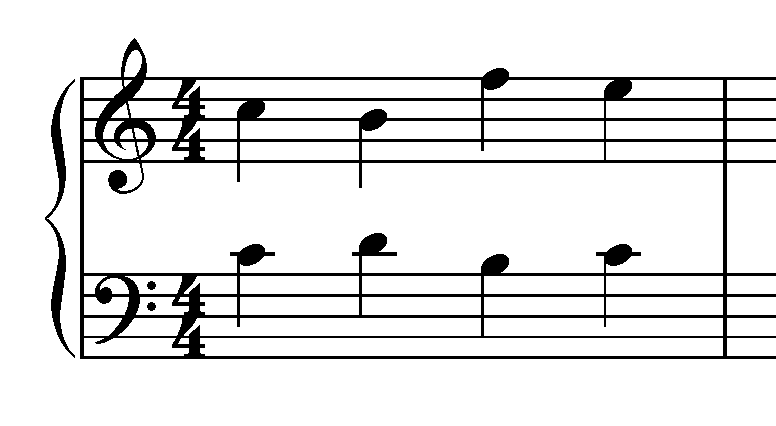
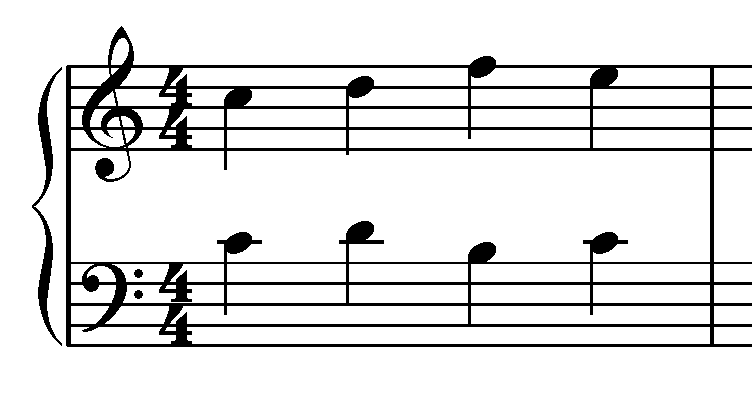

 The Meyer was a popular choice among composers for themes of structural importance in a piece of music. The Meyer features four events presented in pairs of two. The melody features a first descent from scale degree 1 to scale degree 7 in the first pair of events, and then a second descent from scale degree 4 to scale degree 3 in the second pair. The bassline features a stepwise ascent from scale degree 1 to scale degree 2 in the first pair and another stepwise ascent from scale degree 7 to scale degree 1 in the second pair of events. This establishes a tonic function to dominant function "opening" of the harmonic progression in the first pair of events, and then a dominant function to tonic function "closing" of the phrase in the second pair. The Meyer has three related schemas: the Jupiter, the Pastorella, and the Aprile, with their differences being in their melodies. The Jupiter, named after Mozart's Symphony No. 41, features a melody with scale degree 1 to scale degree 2 in the opening pair of events and scale degree 4 to scale degree 3 in the closing. The Pastorella melody features scale degree 3 to scale degree 2 in the opening and scale degree 4 to scale degree 3 in the closing. Lastly, the Aprile melody features scale degree 1 to scale degree 7 in the opening and scale degree 2 to scale degree 1 in the closing. The bassline and harmonic function for the Meyer, Jupiter, Pastorella, and Aprile, however, are similar in that they establish tonic function going to dominant function in the opening and dominant function going to tonic function in the closing.
The Meyer was a popular choice among composers for themes of structural importance in a piece of music. The Meyer features four events presented in pairs of two. The melody features a first descent from scale degree 1 to scale degree 7 in the first pair of events, and then a second descent from scale degree 4 to scale degree 3 in the second pair. The bassline features a stepwise ascent from scale degree 1 to scale degree 2 in the first pair and another stepwise ascent from scale degree 7 to scale degree 1 in the second pair of events. This establishes a tonic function to dominant function "opening" of the harmonic progression in the first pair of events, and then a dominant function to tonic function "closing" of the phrase in the second pair. The Meyer has three related schemas: the Jupiter, the Pastorella, and the Aprile, with their differences being in their melodies. The Jupiter, named after Mozart's Symphony No. 41, features a melody with scale degree 1 to scale degree 2 in the opening pair of events and scale degree 4 to scale degree 3 in the closing. The Pastorella melody features scale degree 3 to scale degree 2 in the opening and scale degree 4 to scale degree 3 in the closing. Lastly, the Aprile melody features scale degree 1 to scale degree 7 in the opening and scale degree 2 to scale degree 1 in the closing. The bassline and harmonic function for the Meyer, Jupiter, Pastorella, and Aprile, however, are similar in that they establish tonic function going to dominant function in the opening and dominant function going to tonic function in the closing.
 The Quiescenza was used by composers to prolong the tonic following a significant section-ending cadence. As the Quiescenza's function is to rest the music on a tonic harmony, it was also often used in the beginning of pieces to strongly establish the key center. The Quiescenza features four events, with the melody first descending from flat scale degree 7 to scale degree 6, and then ascending from scale degree 7 to scale degree 1. The Quiescenza bass rests on a tonic pedal for its full duration.
The Quiescenza was used by composers to prolong the tonic following a significant section-ending cadence. As the Quiescenza's function is to rest the music on a tonic harmony, it was also often used in the beginning of pieces to strongly establish the key center. The Quiescenza features four events, with the melody first descending from flat scale degree 7 to scale degree 6, and then ascending from scale degree 7 to scale degree 1. The Quiescenza bass rests on a tonic pedal for its full duration.
 The Ponte acts as a prolongation of a dominant sonority. A Ponte melody typically emphasizes tones of the dominant or dominant seventh harmony, and the bass features repetitions of the fifth scale degree, if not an outright pedal.
The Ponte acts as a prolongation of a dominant sonority. A Ponte melody typically emphasizes tones of the dominant or dominant seventh harmony, and the bass features repetitions of the fifth scale degree, if not an outright pedal.


 The Fenaroli features four events, with the melody featuring a descent from scale degree 4 to scale degree 3 followed by an ascent from scale degree 7 to scale degree 1. The Fenaroli bass features a stepwise ascent from scale degrees 7 to 3. Another common Fenaroli melody is scale degree 2 to scale degree 3, then scale degree 7 to scale degree 1, which creates a
The Fenaroli features four events, with the melody featuring a descent from scale degree 4 to scale degree 3 followed by an ascent from scale degree 7 to scale degree 1. The Fenaroli bass features a stepwise ascent from scale degrees 7 to 3. Another common Fenaroli melody is scale degree 2 to scale degree 3, then scale degree 7 to scale degree 1, which creates a
 The Sol-Fa-Mi is another opening gambit. Perceived as less bold than a Do-Re-Mi or a Meyer, The Sol-Fa-Mi was typically used for slow movement themes or secondary material in faster, more complex movements. The Sol-Fa-Mi is presented as a pair of dyads. The first and second events feature a melody that steps down from scale degree 5 to 4 and a bass that steps up from scale degree 1 to 2. The third and fourth events feature the melody continuing to step down, this time from scale degree 4 to 3, while the bass steps up from scale degree 7 to 1.
The Sol-Fa-Mi is another opening gambit. Perceived as less bold than a Do-Re-Mi or a Meyer, The Sol-Fa-Mi was typically used for slow movement themes or secondary material in faster, more complex movements. The Sol-Fa-Mi is presented as a pair of dyads. The first and second events feature a melody that steps down from scale degree 5 to 4 and a bass that steps up from scale degree 1 to 2. The third and fourth events feature the melody continuing to step down, this time from scale degree 4 to 3, while the bass steps up from scale degree 7 to 1.
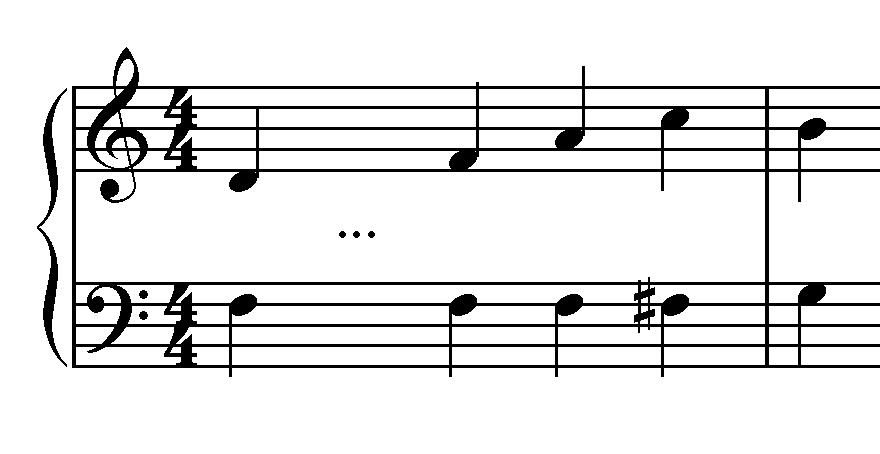 As the Ponte serves to prolong a dominant sonority, the Indugio is a prolongation of a predominant sonority before a half cadence. In an Indugio, the melody will often highlight scale degrees 2, 4, and 6, while the bass will emphasize scale degree 4, preparing to go to scale degree 5 for the half cadence.
As the Ponte serves to prolong a dominant sonority, the Indugio is a prolongation of a predominant sonority before a half cadence. In an Indugio, the melody will often highlight scale degrees 2, 4, and 6, while the bass will emphasize scale degree 4, preparing to go to scale degree 5 for the half cadence.
Robert Gjerdingen
Robert O. Gjerdingen is a scholar of music theory and music perception, and is an emeritus professor at Northwestern University. His most influential work focuses on the application of ideas from cognitive science, especially theories about sc ...
in '' Music in the Galant Style'', are "stock musical phrases" in Galant music
In music, galant refers to the style which was fashionable from the 1720s to the 1770s. This movement featured a return to simplicity and immediacy of appeal after the complexity of the late Baroque era. This meant simpler, more song-like melodi ...
. The concept of a musical schema is based on schema theory in psychology. Each schema has discernible internal characteristics—such as voice leading, number of events, and relative metric
Metric or metrical may refer to:
* Metric system, an internationally adopted decimal system of measurement
* An adjective indicating relation to measurement in general, or a noun describing a specific type of measurement
Mathematics
In mathem ...
strength and weakness of such events—as well as normative placements in the musical structure as a whole. According to Gjerdingen, the usage of these schemata in a conventional, seamless sequence is "a hallmark of the galant style" and a consequence of the partimento
A Partimento (from the Italian: ''partimento'', plural ''partimenti'') is a sketch (often a bass line), written out on a single staff, whose main purpose is to be a guide for the improvisation ("realization") of a composition at the keyboard. A ...
pedagogical tradition of Neapolitan conservatories.
Different schemata and their descriptions
Romanesca
 The
The Romanesca
Romanesca is a melodic-harmonic formula popular from the mid–16th to early–17th centuries that was used as an aria formula for singing poetry and as a subject for instrumental variation. The pattern, which is found in an endless collection of ...
originated from the 16th and 17th centuries as a common musical backdrop in a minor key
In Western music, the adjectives major and minor may describe a chord, scale, or key. As such, composition, movement, section, or phrase may be referred to by its key, including whether that key is major or minor.
Intervals
Some intervals ...
for singing poetry as well as the basis for variations over a repeating harmonic progression. The later Romanesca is a similar progression and features three variants: the leaping variant, the stepwise variant, and the galant variant, a hybrid of the previous two. Gjerdingen describes the Romanesca as an "opening gambit," meaning that the normative placement of the Romanesca would conventionally be found at the beginning of phrasal structure. A Romanesca melody usually features emphases on scale degrees 1 and 5.


Prinner
 Gjerdingen describes the Prinner as a "riposte" to an opening schema. A Prinner melody features some form of stepwise descent from scale degree 6 to scale degree 3, and the bassline features stepwise descent from scale degree 4 to scale degree 1. A variant of this schema exists with an optional extension in the third event with scale degree 5 in the bass to strengthen the finality of the musical phrase. Composers in the galant period also favored the Prinner as a useful way to modulate from a key to its dominant. Prinners used in this manner are distinguished as modulating Prinners.
Gjerdingen describes the Prinner as a "riposte" to an opening schema. A Prinner melody features some form of stepwise descent from scale degree 6 to scale degree 3, and the bassline features stepwise descent from scale degree 4 to scale degree 1. A variant of this schema exists with an optional extension in the third event with scale degree 5 in the bass to strengthen the finality of the musical phrase. Composers in the galant period also favored the Prinner as a useful way to modulate from a key to its dominant. Prinners used in this manner are distinguished as modulating Prinners.
Fonte
 The Fonte features four events in two groups of two, or "dyads". The first group is a pair of harmonies in a minor key, and the second group is in a major key. Composers used the Fonte to briefly deviate from the main key of a piece, essentially tonicizing the supertonic of the main key in the first group of events and following it with cadential action in the main key in the second group. The Fonte melody typically features two recognizable sets, corresponding to the two groups of events. The second melodic set in a Fonte is a step lower than the first set. A concept related to the Fonte is the descending fifth
The Fonte features four events in two groups of two, or "dyads". The first group is a pair of harmonies in a minor key, and the second group is in a major key. Composers used the Fonte to briefly deviate from the main key of a piece, essentially tonicizing the supertonic of the main key in the first group of events and following it with cadential action in the main key in the second group. The Fonte melody typically features two recognizable sets, corresponding to the two groups of events. The second melodic set in a Fonte is a step lower than the first set. A concept related to the Fonte is the descending fifth sequence
In mathematics, a sequence is an enumerated collection of objects in which repetitions are allowed and order matters. Like a set, it contains members (also called ''elements'', or ''terms''). The number of elements (possibly infinite) is calle ...
.
Do-Re-Mi

 The Do-Re-Mi is another common "opening gambit." This schema features three events. Like the name suggests, a Do-Re-Mi melody features stepwise ascent from scale degree 1 to scale degree 3. In the bass, scale degree 1 to scale degree 7 to scale degree 1 is common, as well as scale degree 1 to scale degree 5 to scale degree 1. These three events imply a tonic function in the first event, a dominant function in the second event, and a tonic function again in the third event. A variant called the
The Do-Re-Mi is another common "opening gambit." This schema features three events. Like the name suggests, a Do-Re-Mi melody features stepwise ascent from scale degree 1 to scale degree 3. In the bass, scale degree 1 to scale degree 7 to scale degree 1 is common, as well as scale degree 1 to scale degree 5 to scale degree 1. These three events imply a tonic function in the first event, a dominant function in the second event, and a tonic function again in the third event. A variant called the Adeste Fidelis
"O Come, All Ye Faithful" (originally written in Latin as "") is a Christmas carol that has been attributed to various authors, including John Francis Wade (1711–1786), John Reading (1645–1692), King John IV of Portugal (1604–1656), and a ...
variant features leaps down to scale degree 5 in the melody.
Monte
 The Monte, like the Fonte, also features events grouped by two. However, unlike the Fonte, it is not uncommon to find early Montes with more than two sections. Later Montes featured mostly featured two sections, the first of which would contain two harmonic events centering around the subdominant of the main key, and the second of which would also contain two events centering the dominant, usually to make up a cadence. The Monte melody features two sections. Typically, the second section is a near copy of the first, but a step higher. The Monte bassline also usually features a melodic ascent. A similar concept to the Monte is the ascending tenths sequence.
The Monte, like the Fonte, also features events grouped by two. However, unlike the Fonte, it is not uncommon to find early Montes with more than two sections. Later Montes featured mostly featured two sections, the first of which would contain two harmonic events centering around the subdominant of the main key, and the second of which would also contain two events centering the dominant, usually to make up a cadence. The Monte melody features two sections. Typically, the second section is a near copy of the first, but a step higher. The Monte bassline also usually features a melodic ascent. A similar concept to the Monte is the ascending tenths sequence.
Meyer, Jupiter, Pastorella, and Aprile



 The Meyer was a popular choice among composers for themes of structural importance in a piece of music. The Meyer features four events presented in pairs of two. The melody features a first descent from scale degree 1 to scale degree 7 in the first pair of events, and then a second descent from scale degree 4 to scale degree 3 in the second pair. The bassline features a stepwise ascent from scale degree 1 to scale degree 2 in the first pair and another stepwise ascent from scale degree 7 to scale degree 1 in the second pair of events. This establishes a tonic function to dominant function "opening" of the harmonic progression in the first pair of events, and then a dominant function to tonic function "closing" of the phrase in the second pair. The Meyer has three related schemas: the Jupiter, the Pastorella, and the Aprile, with their differences being in their melodies. The Jupiter, named after Mozart's Symphony No. 41, features a melody with scale degree 1 to scale degree 2 in the opening pair of events and scale degree 4 to scale degree 3 in the closing. The Pastorella melody features scale degree 3 to scale degree 2 in the opening and scale degree 4 to scale degree 3 in the closing. Lastly, the Aprile melody features scale degree 1 to scale degree 7 in the opening and scale degree 2 to scale degree 1 in the closing. The bassline and harmonic function for the Meyer, Jupiter, Pastorella, and Aprile, however, are similar in that they establish tonic function going to dominant function in the opening and dominant function going to tonic function in the closing.
The Meyer was a popular choice among composers for themes of structural importance in a piece of music. The Meyer features four events presented in pairs of two. The melody features a first descent from scale degree 1 to scale degree 7 in the first pair of events, and then a second descent from scale degree 4 to scale degree 3 in the second pair. The bassline features a stepwise ascent from scale degree 1 to scale degree 2 in the first pair and another stepwise ascent from scale degree 7 to scale degree 1 in the second pair of events. This establishes a tonic function to dominant function "opening" of the harmonic progression in the first pair of events, and then a dominant function to tonic function "closing" of the phrase in the second pair. The Meyer has three related schemas: the Jupiter, the Pastorella, and the Aprile, with their differences being in their melodies. The Jupiter, named after Mozart's Symphony No. 41, features a melody with scale degree 1 to scale degree 2 in the opening pair of events and scale degree 4 to scale degree 3 in the closing. The Pastorella melody features scale degree 3 to scale degree 2 in the opening and scale degree 4 to scale degree 3 in the closing. Lastly, the Aprile melody features scale degree 1 to scale degree 7 in the opening and scale degree 2 to scale degree 1 in the closing. The bassline and harmonic function for the Meyer, Jupiter, Pastorella, and Aprile, however, are similar in that they establish tonic function going to dominant function in the opening and dominant function going to tonic function in the closing.
Quiescenza
 The Quiescenza was used by composers to prolong the tonic following a significant section-ending cadence. As the Quiescenza's function is to rest the music on a tonic harmony, it was also often used in the beginning of pieces to strongly establish the key center. The Quiescenza features four events, with the melody first descending from flat scale degree 7 to scale degree 6, and then ascending from scale degree 7 to scale degree 1. The Quiescenza bass rests on a tonic pedal for its full duration.
The Quiescenza was used by composers to prolong the tonic following a significant section-ending cadence. As the Quiescenza's function is to rest the music on a tonic harmony, it was also often used in the beginning of pieces to strongly establish the key center. The Quiescenza features four events, with the melody first descending from flat scale degree 7 to scale degree 6, and then ascending from scale degree 7 to scale degree 1. The Quiescenza bass rests on a tonic pedal for its full duration.
Ponte
 The Ponte acts as a prolongation of a dominant sonority. A Ponte melody typically emphasizes tones of the dominant or dominant seventh harmony, and the bass features repetitions of the fifth scale degree, if not an outright pedal.
The Ponte acts as a prolongation of a dominant sonority. A Ponte melody typically emphasizes tones of the dominant or dominant seventh harmony, and the bass features repetitions of the fifth scale degree, if not an outright pedal.
Fenaroli


 The Fenaroli features four events, with the melody featuring a descent from scale degree 4 to scale degree 3 followed by an ascent from scale degree 7 to scale degree 1. The Fenaroli bass features a stepwise ascent from scale degrees 7 to 3. Another common Fenaroli melody is scale degree 2 to scale degree 3, then scale degree 7 to scale degree 1, which creates a
The Fenaroli features four events, with the melody featuring a descent from scale degree 4 to scale degree 3 followed by an ascent from scale degree 7 to scale degree 1. The Fenaroli bass features a stepwise ascent from scale degrees 7 to 3. Another common Fenaroli melody is scale degree 2 to scale degree 3, then scale degree 7 to scale degree 1, which creates a canon
Canon or Canons may refer to:
Arts and entertainment
* Canon (fiction), the conceptual material accepted as official in a fictional universe by its fan base
* Literary canon, an accepted body of works considered as high culture
** Western ca ...
with the bass. A countermelody exists for the Fenaroli, as taught by Francesco Durante
Francesco Durante (31 March 1684 – 30 September 1755) was a Neapolitan composer.
Biography
He was born at Frattamaggiore, in the Kingdom of Naples, and at an early age he entered the '' Conservatorio dei poveri di Gesù Cristo'', in Naples, ...
.
Sol-Fa-Mi
 The Sol-Fa-Mi is another opening gambit. Perceived as less bold than a Do-Re-Mi or a Meyer, The Sol-Fa-Mi was typically used for slow movement themes or secondary material in faster, more complex movements. The Sol-Fa-Mi is presented as a pair of dyads. The first and second events feature a melody that steps down from scale degree 5 to 4 and a bass that steps up from scale degree 1 to 2. The third and fourth events feature the melody continuing to step down, this time from scale degree 4 to 3, while the bass steps up from scale degree 7 to 1.
The Sol-Fa-Mi is another opening gambit. Perceived as less bold than a Do-Re-Mi or a Meyer, The Sol-Fa-Mi was typically used for slow movement themes or secondary material in faster, more complex movements. The Sol-Fa-Mi is presented as a pair of dyads. The first and second events feature a melody that steps down from scale degree 5 to 4 and a bass that steps up from scale degree 1 to 2. The third and fourth events feature the melody continuing to step down, this time from scale degree 4 to 3, while the bass steps up from scale degree 7 to 1.
Indugio
 As the Ponte serves to prolong a dominant sonority, the Indugio is a prolongation of a predominant sonority before a half cadence. In an Indugio, the melody will often highlight scale degrees 2, 4, and 6, while the bass will emphasize scale degree 4, preparing to go to scale degree 5 for the half cadence.
As the Ponte serves to prolong a dominant sonority, the Indugio is a prolongation of a predominant sonority before a half cadence. In an Indugio, the melody will often highlight scale degrees 2, 4, and 6, while the bass will emphasize scale degree 4, preparing to go to scale degree 5 for the half cadence.
Bibliography
References
{{Reflist Musicology